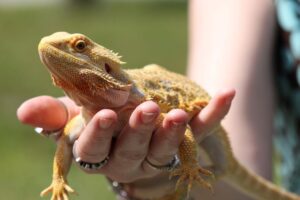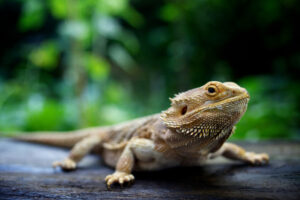Feeding bearded dragons is a crucial aspect of their care, and one dietary option that often sparks interest and curiosity among reptile enthusiasts is the inclusion of pinky mice in their menu. Bearded dragons, known for their unique dietary requirements, thrive on a diverse diet that mimics their natural habitat.
In this context, incorporating pinky mice into the feeding regimen has become a topic of discussion and consideration among reptile keepers. Bearded dragon pinky mice, as a specific aspect of their nutrition, introduces an additional dimension to their dietary intake, potentially offering a rich source of protein and other essential nutrients.
So, on this article, we delve into the concept of feeding bearded dragons pinky mice, examining the nutritional aspects, potential benefits, and important considerations for ensuring the well-being of these captivating reptiles.
Are pinky mice a suitable diet for bearded dragons?

Pinky mice, which are newborn mice that have not yet developed fur, are generally not recommended as a primary diet for bearded dragons. Bearded dragons are omnivores, and their natural diet consists of a variety of insects, vegetables, and some fruits. In the wild, they consume a mix of invertebrates and plant matter.
While some reptile owners may occasionally offer small amounts of appropriately sized feeder mice as a treat, it’s important not to make them a staple in a bearded dragon’s diet. Feeder mice lack many of the essential nutrients that bearded dragons need for proper growth and development.
The main components of a bearded dragon’s diet should include a variety of insects such as crickets, mealworms, and dubia roaches, as well as a selection of leafy greens and vegetables. Commercially available reptile supplements can also be used to ensure that your bearded dragon receives all the necessary vitamins and minerals.
Always consult with a veterinarian who specializes in reptile care for guidance on the specific dietary needs of your individual bearded dragon, as nutritional requirements can vary based on factors such as age, size, and health status.
How often should I feed pinky mice to my bearded dragon?
Feeding pinky mice to a bearded dragon is not recommended as a regular part of their diet. Bearded dragons are primarily insectivores, and their diet should consist mainly of insects, vegetables, and some fruits. Pinky mice are high in fat and may not provide the balanced nutrition that a bearded dragon needs.
For a healthy adult bearded dragon, you can feed it a variety of appropriately sized insects such as crickets, dubia roaches, mealworms, superworms, and phoenix worms. About 80% of their diet should consist of insects when they are young, gradually decreasing to around 20-30% as they mature.
Vegetables and fruits are also essential components of their diet. Provide a mix of dark, leafy greens, and a variety of colorful vegetables and fruits. Dusting insects with a calcium supplement is recommended to ensure that your bearded dragon gets adequate calcium.
If you have concerns about your bearded dragon’s diet or nutritional needs, it’s always a good idea to consult with a reptile veterinarian for personalized advice based on your specific dragon’s health, age, and size.
What nutrients do pinky mice provide for bearded dragons?
While pinky mice do contain some nutrients, they are not considered a natural or essential part of a bearded dragon’s diet. Bearded dragons are primarily insectivores, and their nutritional needs are best met through a diet that includes a variety of insects, vegetables, and some fruits.
Here are some key nutrients that bearded dragons require and how they can be obtained from a balanced diet:
- Protein: Insects such as crickets, dubia roaches, mealworms, and superworms are excellent sources of protein for bearded dragons.
- Calcium: Dark, leafy greens like kale and collard greens, as well as calcium-rich vegetables, contribute to a bearded dragon’s calcium intake. Additionally, calcium supplements can be dusted onto insects.
- Vitamins and Minerals: A diverse range of vegetables and fruits, such as carrots, bell peppers, and berries, can provide essential vitamins and minerals.
- Fiber: Vegetables and some fruits contain fiber, which is important for digestive health.
- Hydration: Vegetables and fruits with high water content, along with regular access to fresh water, help keep bearded dragons hydrated.
Pinky mice are high in fat and may not provide the balanced nutritional profile that bearded dragons need. Feeding them too frequently can lead to obesity and other health issues. If you are considering introducing new foods into your bearded dragon’s diet, it’s crucial to do so gradually and ensure that the overall diet remains balanced.
Always consult with a reptile veterinarian for guidance on the best diet for your individual bearded dragon based on its age, size, and health status.
Health risks associated with a pinky mice diet

Feeding a pinky mice diet to bearded dragons can pose several health risks, as it may not provide the balanced nutrition that these reptiles need.
Here are some potential health issues associated with a diet primarily consisting of pinky mice:
- Nutritional Imbalance: Pinky mice are high in fat and protein but may lack essential vitamins and minerals required for the overall health of bearded dragons. A diet that lacks variety can lead to nutritional imbalances and deficiencies.
- Obesity: Pinky mice are relatively high in fat, and feeding them too frequently can lead to obesity in bearded dragons. Obesity is a serious health concern that can impact the dragon’s mobility, organ function, and overall well-being.
- Calcium-Phosphorus Imbalance: Pinky mice may have an imbalanced calcium-to-phosphorus ratio, which is crucial for maintaining proper bone health in reptiles. Bearded dragons require a diet with an appropriate calcium-phosphorus balance to prevent metabolic bone disease.
- Digestive Issues: The digestive system of bearded dragons is adapted to process a diet that includes insects, vegetables, and fruits. A sudden shift to a diet primarily consisting of pinky mice may lead to digestive problems, including constipation or impaction.
- Liver and Kidney Strain: Excessive intake of certain nutrients, such as fat and protein, can strain the liver and kidneys of bearded dragons. This can lead to long-term health issues and reduced lifespan.
It’s important you know that pinky fuzzies mice are not a natural part of the bearded dragon’s diet in the wild, and their nutritional needs are best met through a varied and balanced diet that mimics their natural feeding habits.
If you have concerns about your bearded dragon’s diet or health, it’s recommended to consult with a reptile veterinarian. They can provide guidance on an appropriate diet based on your dragon’s age, size, and health status.
Alternative protein sources for bearded dragons
Bearded dragons are omnivores, meaning they eat a combination of animal and plant matter. In addition to insects, there are several alternative protein sources you can offer to ensure a varied and balanced diet for your bearded dragon.
Here are some alternative protein sources:
- Dubia Roaches: These are a popular feeder insect for bearded dragons. They are rich in protein and have a good calcium-to-phosphorus ratio.
- Phoenix Worms (Black Soldier Fly Larvae): These larvae are high in calcium and low in fat, making them a nutritious option for bearded dragons.
- Silkworms: Silkworms are another excellent source of protein for bearded dragons. They are relatively soft-bodied and easy to digest.
- Crickets: Crickets are a common and readily available feeder insect. They are a good source of protein, but it’s essential to gut-load them with nutritious foods before feeding them to your bearded dragon.
- Hornworms: These caterpillars are high in water content and can be a good hydration source for bearded dragons. They are also a decent source of protein.
- Superworms: Superworms are another option, but they should be fed in moderation due to their higher fat content. They can be a good treat but should not make up the primary protein source.
- Mealworms: While mealworms are commonly offered, they should be used sparingly due to their harder exoskeleton, which can be more challenging to digest. It’s better to offer them as an occasional treat.
It’s crucial to provide a diverse diet by incorporating various insects and occasionally offering small amounts of vegetables and fruits. Ensure that the insects are appropriately sized for your bearded dragon’s age and size, and always dust them with a calcium supplement before feeding to maintain a proper calcium-to-phosphorus ratio.
Consult with a reptile veterinarian to create a balanced and species-appropriate diet plan for your individual bearded dragon, taking into consideration factors such as age, size, and overall health.
Conclusion
Feeding bearded dragons pinky mice is generally not recommended as a staple diet. Bearded dragons are omnivores that primarily require a mix of insects and plant matter. Pinky mice lack essential nutrients and may upset the balance in a bearded dragon’s diet.
It’s crucial to focus on appropriate feeder insects, such as crickets, dubia roaches, and mealworms, supplemented with a variety of vegetables. Always consult with a reptile veterinarian for personalized dietary advice tailored to your bearded dragon’s specific needs.

